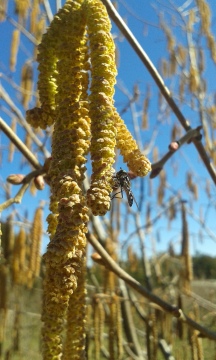When we think about planting for pollinators, the first plants we reach for are often ones with obvious flowers, usually bright and showy, perhaps with an attractive scent, and lots of pollen and nectar. Most of these will be insect-pollinated plants, which is why they are so attractive to pollinator insects – they have co-evolved with pollinators to reap the reproductive benefits of insect visitation.
But pollinators also use plenty of other plants that we wouldn’t think of as being ‘pollinator plants’, particularly plants that are pollinated by wind, like conifers and grasses. Some grasses are pollinated by bees. And some bees feed on fungi. These interactions have been observed by scientists and naturalists for centuries, but are often forgotten when we talk about pollinator conservation.
This is one of the key challenges with the ecosystem services concept. Trying to justify conservation of pollinator insects because they provide us with benefits, i.e. fruits and seeds from plants they pollinate, is not always useful. Partly because this approach overlooks the fact that pollinators also need lots of other resources to survive, some of which we may not benefit from. And separating ‘insect-pollinated crops’ (e.g. almonds, stonefruit, berries) from ‘wind-pollinated crops’ (e.g. wheat, rice, corn) when we talk about managing farms for pollinator conservation, ignores the fact that some pollinators will regularly visit wind-pollinated crops to collect pollen for food.
I’m currently writing a review of records of pollinator species visiting plant species that we traditionally assume to be wind-pollinated, after noticing some of these interactions at field sites and in my own garden (stay tuned!). I didn’t find any records of some of these plant-pollinator interactions in my literature review, so I’m recording them here. One-off ecological observations are rarely accepted by academic journals, because they are not considered scientific studies. But, in conjunction with other knowledge, they can provide important information for future research hypotheses.
Olive
Research has shown that olive trees don’t need insects to improve fruit yields, although it’s possible this differs between varieties. However, European honey bees (Apis mellifera), non-Apis bee species and hoverflies (Syrphidae) have been recorded visiting olive flowers in Italian olive groves.


Grapes
Grapes are another fruit crop that usually doesn’t need insects to set fruit, although some varieties may. Regardless of fruit set, pollinators will still visit grape flowers if they’re around.

Cypress
Conifers are wind-pollinated and don’t need insects to spread pollen between male and female flowers. But this doesn’t mean pollinators don’t visit. Conifers are an important source of resins for some bee species, who use it to build nests and as chemical defence against predators. But they can also visit while the trees are in ‘flower’ (conifers are gymnosperms, which don’t produce flowers). We have a few cypress varieties in our garden and honey bees and flower wasps are regular visitors to the female ‘flowers’ to collect resins or essential oils.

Hazelnut
This is another one of our favourite wind-pollinated crops that doesn’t need insects to produce yields. But the catkins that appear in late winter provide high-quality pollen for honey bees and lots of other bee, fly and wasp species that are out looking for food when not much else is flowering.


Ginkgo
Ginkgo biloba is fascinating plant. At least 10 species of Ginkgo are known from prehistory, but G. biloba is the only extant species we can see growing today. Ginkgos (sometimes called maidenhair trees because of their distinctive leaf shapes) are a gymnosperm, like conifers, meaning they don’t produce true flowers and are wind-pollinated. I have trawled the internet and scientific literature but haven’t been able to find any records of pollinators visiting Ginkgo reproductive parts.
However, bee biologist Robert Schmalzel published a call for records of honey bees on Ginkgos in the American Bee Journal in 1980, so it’s clearly not unheard of. I live in Albury, a regional town in southern New South Wales, and I have only seen 3 Ginkgo trees in my home range. More importantly, I have seen honey bees and hoverflies on reproductive parts of both male and female trees (growing a few kilometres apart).

© Manu Saunders 2016
Sounds like a very valuable review! Can’t wait to read it
LikeLiked by 1 person
Include them in a supplement! Its worthwhile to have these recorded in the literature somewhere for the next person (as you couldn’t find them for your review).
http://onlinelibrary.wiley.com/doi/10.1002/bes2.1239/full (shameless self-promotion, but in the name of natural history!).
(stuff occasionally visits Chenopodium spp. flowers, too, which are wind-pollinated, though I don’t have any photos)
LikeLiked by 1 person
Great paper, thanks for the link. I published the observations here on my blog so I could cite them in my review – but supp material is a good idea too!
LikeLike